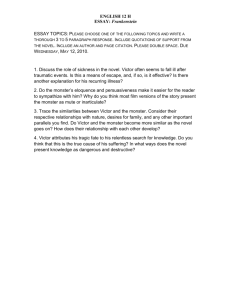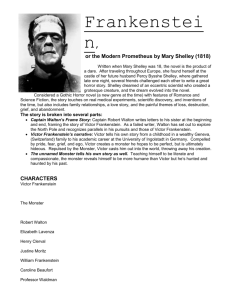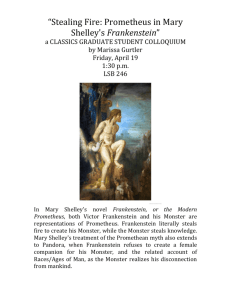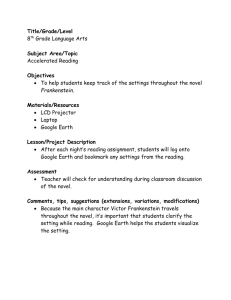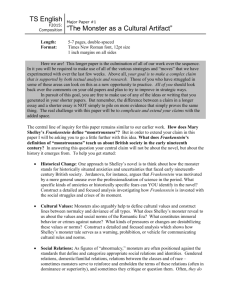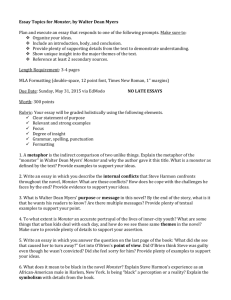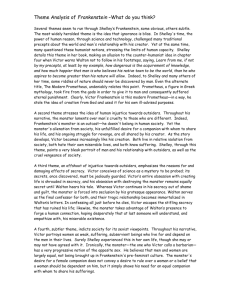Frankenstein - English
advertisement
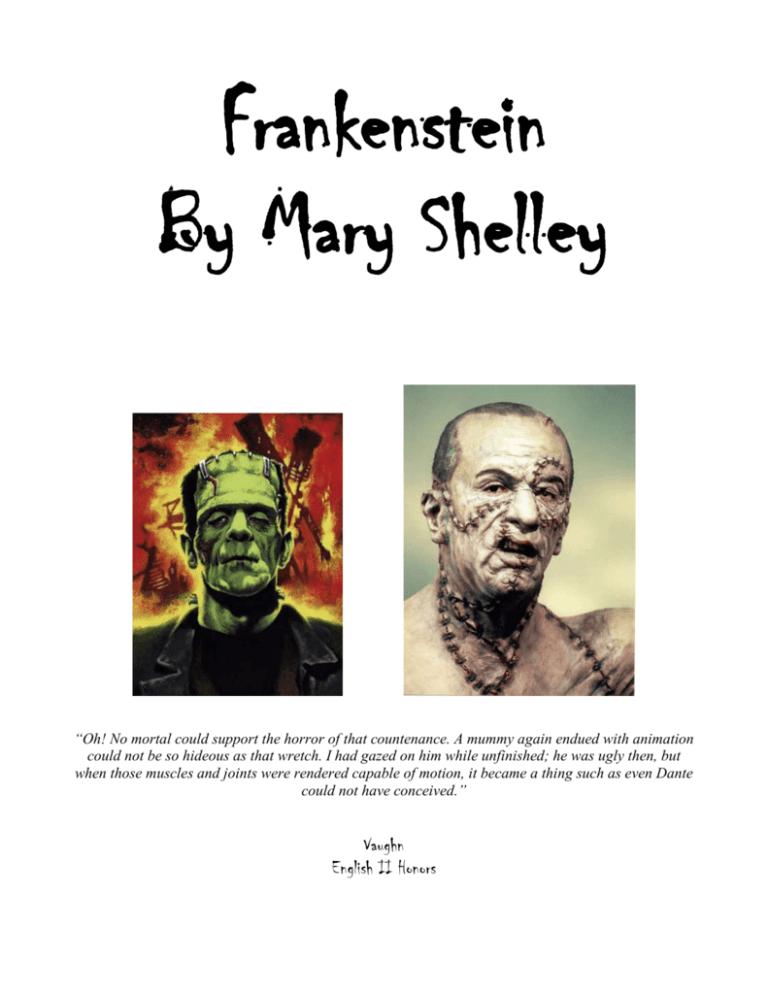
Frankenstein By Mary Shelley “Oh! No mortal could support the horror of that countenance. A mummy again endued with animation could not be so hideous as that wretch. I had gazed on him while unfinished; he was ugly then, but when those muscles and joints were rendered capable of motion, it became a thing such as even Dante could not have conceived.” Vaughn English II Honors Unit Schedule We will discuss Frankenstein on every B-day, while on the other days we will work on poetry from the textbook. On each of those B-days, you must come to class with the following: Your quote journals, which includes the interesting quotes you’ve pulled, context, and analysis. Chapter notes on themes, symbols and other literary elements, and anything else you feel needs to be discussed. Analysis of any quotes in your packet that are included in your reading. Answers to any of the discussion questions in your packet that apply to your reading. Be ready to have a graded discussion, during which the quality of your participation will matter. Due Dates: Background Research and Presentations: Monday 10/29/12 Chapters 1-8: Mon. 11/5/12 Chapters 9-16: Wed. 11/14/12 Chapters 17-24: Wed. 11/28/11 Quote Journal You will be responsible for keeping a quote journal in your notebooks throughout your reading. As you read, record quotes from the text that develop the various themes in the novel. You do not need to stick to just one theme. Explore your options. Some of the central themes in the novel include: Idealism Vengeance The quest for knowledge Compassion Self-destruction Destiny and free will Isolation Appearance For each entry, you must include: 1. the quote; the chapter/page number 2. theme 3. context notes 4. analysis notes You may format this in linear form as a running journal or in chart form. For example: Quote “Frankenstein! You belong then to my enemy – to him towards whom I have sworn eternal revenge; you shall be my first victim.” (Chapter 16) Theme Vengeance Context Monster learns that everyone is disgusted by him so he swears revenge on basically everyone, including Frankenstein. Shows some compassion by rescuing a girl. Gets shot by a man who thinks monster is attacking the girl. Hides out in woods. Goes to Geneva and finds Victor’s bro, William. Strangles him. Requirements: At least one quote per chapter Themes may vary Full sentences are not necessary, but full thoughts are All four elements for every quote Analysis Feeling very slighted, frustrated, misunderstood. The monster decides to kill William because he is related to Victor. He hopes that he can make Victor as alone and miserable as he is himself. The idea of revenge consumes the creature and he will go to any extent to get it. In fact, it’s all consuming and his reason for being now. It doesn’t seem there will be any turning back Research and Presentation Directions: Research your assigned topic with your group. Be thorough and detailed. Provide a works-cited page. Do not use Wikipedia. Provide one visual aid to help the class understand your topic. 1. British Romanticism - elements, significant authors and titles 2. Horror stories as a genre - elements, history, significant authors and titles 3. The Myth of Prometheus - origins and description 4. Global events in 1816 - industrial revolution, science, medical advances 5. Events in Shelley's life that lead to her writing Frankenstein 6. Samuel Taylor Coleridge’s Rime of the Ancient Mariner and John Milton’s Paradise Lost - the stories and their lessons. Research and Presentation Rubric Names__________________________________________ Group #_____________ Research detail and accuracy Presentation Visual 10-9 points 8 points 7 points 6 points The research is detailed and thorough. The group has identified clearly all required terms, and the research is correct and accurate The research is mostly detailed and thorough. The group has identified all required terms, and the research is correct and accurate The research is somewhat detailed and thorough. The group has somewhat identified required terms, and the research is mostly correct and accurate The research is not detailed and/or thorough. The group has not identified required terms, and the research may be incorrect and/or inaccurate 5 points 4 points 3 points 2 points The presentation was clear and easy to understand; each group member participated in the presentation The presentation was mostly clear and easy to understand; each group member participated in the presentation The presentation was somewhat clear and easy to understand; each group member participated in the presentation The presentation was unclear and difficult to understand; each group member participated in the presentation. 5 points 4 points 3 points 2 points The visual is creative and detailed, and it clearly represents the topic The visual is mostly creative and mostly detailed, and it represents the topic The visual is somewhat creative and somewhat detailed, and it vaguely represents the topic The visual is barely creative and lacks detail, and it does not represent the topic. Discussion Questions Discussion Questions: Answer the following questions in your own words. There is not always a right answer. Your judgment is important. Be ready to defend your answers by referring to passages in the play. You MUST use your NOTEBOOKS to record your answers. Many of the answers are cumulative, and can be found at different parts of the book. You need to record information as you read. 1. Describe Victor’s response to the monster on the day he gives it life. Do you find his response surprising or credible? Explain. 2. How does the monster show his concern for the De Lacey family? Explain what this concern reveals about the monster’s humanity. 3. Describe how the monster responds to rejection. Find specific examples of rejection in the text and comment on whether people’s reactions to the monster are credible. Comment on whether the monster’s reaction is justified or logical. 4. Describe how the monster learns about his creation. What are his feelings about himself based on this information? Comment on whether his feelings are justified and find a real-life example that applies to this situation. 5. Why does Victor journey to the Orkney Islands? Explain how this journey is significant to the plot. 6. Why does Victor destroy the second creature? What is the effect of this action? 7. Explain how the monster wreaks revenge on Victor’s wedding night. Do his actions affect how you feel about him? Why or why not? 8. Explain the significance of Victor’s first name. What does his name suggest about the narrative? 9. Find several examples of inconsistencies and unlikely events in the novel (e.g. mail sent and received from a ship trapped in ice). How does such a flawed novel still succeed in becoming a classic? 10. Why do significant scenes of confrontation occur on ice? Explain the symbolic significance of ice in the novel. 11. Characterize the use of Mont Blanc as a symbol. 12. Comment on the monster’s first experiences with light and fire. Explain their significance in the plot, their symbolic significance, and their importance as archetypes. 13. Why does the stereotypical “mad scientist” exist in literature, advertising, TV, and movies? Find examples and discuss each one in connection to the novel. 14. Discuss the weakness of female characters (Justine, Elizabeth, Caroline Frankenstein, Safie and Margaret Saville. Find examples from the text. 15. Discuss Frankenstein as a creation myth. 16. Discuss how the Faust legend and the phoenix myth influence the novel. How does 18th century science disprove the writings of the alchemists? 17. Explain why Arthurian romance and the chivalric era are significant to the novel. Contrast Henry Clerval’s idealism with Victor’s obsession with perverted science. 18. Explain why Mary Shelley refers frequently to Samuel Taylor Coleridge’s Rime of the Ancient Mariner and John Milton’s Paradise Lost. 19. List and explain the elements of romanticism that are present in Frankenstein. Quote Analysis Meaning Study: Below are significant words, phrases, or sentences from the story. Explain each in context. 1. I have no ambition to lose my life on the post-road between St. Petersburg and Archangel. (Letter 1) 2. I am going to unexplored regions, to “the land of mist and snow, “but I shall kill no albatross; therefore do not be alarmed for my safety, or if I should come back to you as worn and woeful as the “Ancient Marine.” (Letter 2) 3. The father of their charge was one of those Italians nursed in the memory of the antique glory of Italy – one among the schiavi ognor frementi who exerted himself to obtain the liberty of his country. (chapter 1) 4. In this house I chanced to fid a volume of the work of Cornelius Agrippa. (chapter 2) 5. When I returned home my first care was to procure the whole works of this author, and afterwards of Paracelsus and Albertus Magnus. (chapter 2) 6. I was required to exchange chimeras of boundless grandeur for realities of little worth. (chapter 3) 7. Ever since I was condemned, my confessor has besieged me, he threatened and menaced, until I almost began to think that I was the monster that he said I was. He threatened excommunication and hell fire in my last moments if I continued to obdurate. (chapter 8) 8. Yet you, my creator, detest and spurn me, thy creature, to whom thou art bound by ties only dissoluble by the annihilation of one of us. (chapter 10) 9. Sometimes indeed, I felt a which for happiness; and thought with melancholy delight of my beloved cousin; or longed, with devouring maladie du pays, to see once more the blue lake and rapid Rhone that had been so dear to me in early childhood: but my general state of feeling was a torpor, in which a prison was as welcome a residence as the divinest scene in nature; and these fits were seldom interrupted but by paroxysms of anguish and despair. (chapter 21) 10. His tale is connected and told with an appearance of the simplest truth; yet I own to you that the letters of Felix and Safie, which he showed me, and the apparition of the monster seen from our ship brought to me a greater conviction of the truth of his narrative that his asseverations, however earnest and connected. (Walton’s August 26th Letter ) Film Questions 1. Compare the “it’s alive” scenes from the book and the film. What are some similarities and some differences? Is the film scene effective? Why or why not? 2. List any elements of Romanticism shown in the film. Final Essay Below are some of the central themes in Mary Shelley’s Frankenstein: Idealism Vengeance The quest for knowledge Compassion Self-destruction Destiny and free will Isolation Appearance Choose two of the above themes and write an essay showing how the author develops them in the novel. In your planning, consider the following to help you get organized: Which characters embody or display the above traits and why? How do the characters’ actions affect them, other people, and the world around them? Are there any symbols in the novel that represent the above themes? What is the author’s message in presenting the above themes as she does? Use information from the book and your notes (discussion notes, quote journal) to support your ideas. Use proper MLA format. Refer to the essay rubric for grading information. Rubric for Analysis Essay Vaughn Usage Style Analysis Thesis and organization Category Criteria Poor RATING Exemplary 1. Essay is structured around a valid, insightful, and convincing argument. 5 6 7 8 9 10 2. Thesis is easily identifiable and clearly articulated; it is neither broad nor vague. 5 6 7 8 9 10 3. Thesis is consistently supported with main ideas and details from the text. 5 6 7 8 9 10 5 6 7 8 9 10 5 6 7 8 9 10 5 6 7 8 9 10 5 6 7 8 9 10 8. The essay contains sophisticated transitions to set up ideas and quotations. 5 6 7 8 9 10 9. The essay is virtually free of grammar and usage errors. 5 6 7 8 9 10 10. The essay follows proper MLA format and submission guidelines. 5 6 7 8 9 10 4. Relevant textual evidence is prevalent throughout the essay’s supporting arguments. 5. Analysis of textual evidence and literary elements is concise, accurate, and insightful. 6. The student uses an effective balance of personal interpretation and outside criticism. 7. The introduction and conclusion compellingly utilize all required essay elements. TOTAL: __________ Comments: Rubric for Graded Discussion Vaughn Questioning Asks questions which lead to rich discussion and deeper group understanding Evidence Gives evidence and makes inferences Beginning 0-2 Able to ask a question related to the current discussion Able to locate factual evidence in the text with a page number Developing 3 Able to ask a question which provokes others to respond at a deeper level in the current discussion Locates evidence in support of an idea under discussion Accomplished 4 Able to ask a question which relates the current discussion to previous discussions Exemplary 5 Able to ask a question which connects the current discussion to bigger themes or ideas Uses evidence in the text to expand on, analyze or critique an idea Uses evidence in the text and solid analysis to create a new idea or draw connections among ideas Connects the ideas of several students; move s the conversation forward; balances “air time” with active listening (SLANT); invites quieter students to join the conversation Detailed, neat, thoughtful, and sophisticated Speaking & Listening: Acts to build a group which can collaboratively search for meaning Listens to others Asks questions to clarify what someone has said Builds on another person’s idea; Actively Listens (SLANT) Socratic Seminar Notes Largely Incomplete or Not Attempted Attempted but not finished Complete: raises several questions and several possible answers Final Score: _________/20
